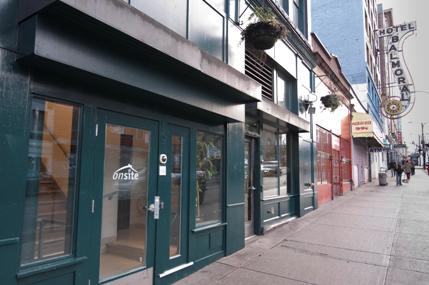10 years of “insight”
Before InSite opened its doors almost exactly a decade ago, Director of Mental Health and Addiction Anne McNabb had worked in the Downtown Eastside for close to 15 years, knowing that a safe injection site would help the people living in the area.
“It made perfect sense to me and the people I was working with,” she says. “We knew that’s what the people of the Downtown Eastside community needed.”

Anne MacNabb talks about her memories at the 10th-anniversary celebration for InSite on September 20th.
Anne sat down with VCH News to talk about how InSite has benefitted people in the Downtown Eastside, what the biggest misconception is about the facility and what she sees happening in the next 10 years.
What memories do you have of when InSite opened?
Well, I worked in the Downtown Eastside for many, many years, starting in the late 80s – I worked for the BCCDC (BC Centre for Disease Control) as the supervisor for the Street Nurse Program for years and later counseling for the Street Project Counseling Services. Because of my work and personal values, I was a very strong advocate for harm reduction.
Back then, the whole topic of supervised injection was pretty high on everyone’s agenda as one possible solution to engage these underserved clients and to reduce the deaths as a result of drug overdose.
Why was that?
Because we could see in the early-90s, before the HIV epidemic was “declared” in 1997, that the rates of HIV were going sky-high and, as well, people were dying from overdoses.
So InSite made perfect sense then…
Yes, it made perfect sense to me and the people I was working with – we knew that’s what the Downtown Eastside needed. During this time, the chief coroner did a report on overdose deaths, which were astronomical at the time.
But it didn’t come without the whole community coming together to make it a reality. As Patty (Daly, Chief Medical Health Officer for VCH) said the other day (at the 10th anniversary celebration), it took that confluence of the community, local government, provincial government, and also federal government – despite some detractors – to support the concept; without that it wouldn’t have happened.
Are you surprised it’s still open 10 years later?
No, I’m not and the reason I’m not is because people fought so hard for it and continue to support it.
I think it’s quite incredible that it’s the only site in North America. I don’t think every city or community necessarily needs a stand-alone supervised injection site, but it should be a part of our normal work, it should be part of harm-reduction strategies at every one of our clinics. I think that in some areas, it could be a discrete service offered at any and all sites where there’s needle distribution.
This might be a dumb question, but has it benefitted the people in the Downtown Eastside?
Oh good lord, yes. In many ways. Number one is that there have been many overdoses but not one death at InSite since it opened (the site’s hosted close to 2 million injections during the 10 years). Also, since opening, the amount of needles and paraphenalia thrown on the streets has definitely been reduced. Another benefit is that people have accessed other health-care services once they have relationships with staff at InSite. That’s what it is: a gateway to other health services if or when people are ready.
What do you think we’ve learned since InSite opened?

Former-mayor Larry Campbell talking to former-deputy police chief Bob Rich at InSite’s grand opening in 2003.
That we need very innovative services that are harm-reduction focused to be able to connect and engage with clients who otherwise we would have little or no contact with. Another is that we know a service like this does save lives because it puts people in direct contact with health-care professionals. Whereas previously, we had so many overdoses that resulted in death – that still happens, but it doesn’t happen at InSite.
I think also that when we truly believe that a service is going to be a benefit to the clients directly – and further, to the community – we have to stand up and say so and not take a back seat.
What’s one of the biggest misconceptions about InSite?
That Insite promotes drug use – what it does is provide a safer, respectful, supervised environment for people to use their drugs and access other services. And I don’t know how many times I’ve corrected the media for saying that client’s are using drugs provided by Insite. That’s incorrect – they bring their own drugs to Insite.
What do see for InSite in the next 10 years?
Well, I hope that we will expand the hours at InSite and increase the capacity – we can be helping far more people. Beyond that, I hope we find other ways to deliver supervised injection as part of our normal health-care services. I think other similar facilities will be opening in other communities where it’s warranted and where it’s needed. I think the federal government has attempted to make it more difficult, but I think people will fight for these services and the proof of what InSite has done will assist in those struggles.

